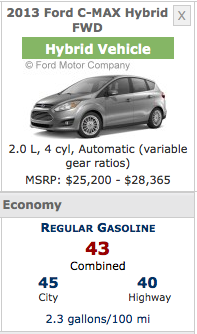Ford: We didn’t overstate C-Max Hybrid mpg, low numbers were a surprise

 There’s kind of a lot to digest in the news about the 2013 Ford C-Max Hybrid EPA label change. In fact, as we tried to really understand how and why Ford downrated the car’s fuel economy from 47 miles per gallon across the board to 43 mpg (combined, with 45 city and 40 on the highway) we learned about the EPA’s so-called “general label rule,” how Ford is now claiming it didn’t fully understand how hybrid fuel economy is affected by factors like driving speed, break-in miles and temperature and why the C-Max Hybrid and Fusion Hybrid – which get counted as the same thing in that general label – are actually two very different beasts. Oh, and that the C-Max Hybrid’s fuel economy was never actually tested.
There’s kind of a lot to digest in the news about the 2013 Ford C-Max Hybrid EPA label change. In fact, as we tried to really understand how and why Ford downrated the car’s fuel economy from 47 miles per gallon across the board to 43 mpg (combined, with 45 city and 40 on the highway) we learned about the EPA’s so-called “general label rule,” how Ford is now claiming it didn’t fully understand how hybrid fuel economy is affected by factors like driving speed, break-in miles and temperature and why the C-Max Hybrid and Fusion Hybrid – which get counted as the same thing in that general label – are actually two very different beasts. Oh, and that the C-Max Hybrid’s fuel economy was never actually tested.
Aside from the $325 or $550 rebates Ford will send to lessees and buyers, we were curious if Ford plans on making any other apologies to C-Max owners for overstating the C-Max fuel economy by six mpg (if we use the pre-software update number, which is what the original mpg figure was based on. More on this below). Todd Nissen, Ford’s manager of corporate communications told AutoblogGreen that, “We don’t agree with the premise of ‘overstating’ the fuel economy. As confirmed by the EPA, Ford complied with EPA regulations in generating the C-Max’s mpg figures. As you know, they were generated under the general label rule, which is a common industry practice.” Let’s clarify what that means below. 
Let’s start with what the general label rule, since that can be pointed to as one cause of the whole problem. Immediately following Ford’s mpg update last week, the EPA released more information on the C-Max situation (PDF), including the answer to this question: “Why Did the Old C-Max Label Claim Higher Fuel Economy?”
Developed in 1977, EPA label regulations allow vehicles with the same engine, transmission and weight class to use the same fuel economy label value data, since, historically, such vehicle families achieve nearly identical fuel economy performance. Ford based the 2013 Ford C-Max label on testing of the related Ford Fusion hybrid, which has the same engine, transmission and test weight as allowed under EPA regulations. For the vast majority of vehicles this approach would have yielded an appropriate label value for the car, but these new vehicles are more sensitive to small design differences than conventional vehicles because advanced highly efficient vehicles use so little fuel. In this case, EPA’s evaluation found that the C-Max’s aerodynamic characteristics resulted in a significant difference in fuel economy from the Fusion hybrid.
Those mpg differences the EPA mentioned, how dramatic were they? The EPA provided a handy chart:

Of course, those are the numbers compared to the C-Max as it stands today, after Ford did a bunch of scrambling this summer in the wake of customer complaints and lawsuits and came up with a software update. That did indeed help the car’s fuel economy, and the EPA says that, without it, the C-Max Hybrid would have been rated at 41 mpg (combined, with 42 city and 40 highway).

Let’s keep these pre-update numbers in mind, since they are what the original mpg label was based on.
Last week, in a conference call with reporters to announce the mpg rating changes for the hybrid C-Max (which does not affect the plug-in model), Ford’s Raj Nair, group vice president for global product development, said:
The C-Max Energi, our plug-in hybrid, and the Fusion Energi, the plug-in hybrid, are under the same general label. But in that case, the C-Max Energi is the high-volume variant, so the Fusion Energi plug-in hybrid shares and carries the C-Max label. If we had actually tested the Fusion individually it probably would have had a higher number, but we carry a lower number because the C-Max is the high-volume variant, relative to the plug-in hybrids. (emphasis added)
The general label rule allowed Ford to determined the official C-Max mpg ratings using the Fusion Hybrid numbers (we all know that the EPA doesn’t test the vehicles itself, but relies on automakers to conduct the tests and then conducts spot checks. For more, Automotive News has a timeline of the back-and-forth between the automakers and the EPA here). The line about the Fusion being more efficient is key here, since it shows that at some point it was clear to Ford engineers that, given the same powertrain, the Fusion was at least in some ways more efficient than the C-Max. This is confirmed by the EPA’s discovery that “the C-Max’s aerodynamic characteristics resulted in a significant difference in fuel economy from the Fusion hybrid.” The question then becomes: when did Ford know that the C-Max was inherently less efficient than the Fusion, and why did it still use use the Fusion’s mpg numbers? This was by all accounts totally legit under the rules, but it does seem to give credence to what Automotive News calls – in an anonymous editorial, no less – a “deception” and “a gross violation of customers’ trust.”
Apparently, the details of just how different the C-Max Hybrid performs in the real real world is all brand new to Ford, despite almost nine months of the car being on the market and lots and lots of promotion of the 47 mpg as a Prius-buster. Last week, Nair also said:
We’ve been working with the EPA, recognizing hybrids are seeing a lot more variability than gasoline engines against the label. [They have] much more sensitivity to speed, sensitivity to environment, much more sensitivity to even break-in miles. So, we’ve been working with the EPA and this test procedure is not a very quick test, there’s a lot involved in preparing vehicles for tests and then actually doing the tests and working hand-in-hand with the EPA, we just came to this conclusion fairly recently.
Here’s the chart Ford used to illustrate the differences:

We asked Ford about the EPA’s numbers and the apparently surprising hybrid discoveries, which struck us as odd since the company has been making hybrid vehicles for years. Nissen told AutoblogGreen:
The results of the EPA certification test of the 2013 C-MAX by itself (outside of the general label) were generated in the last couple of weeks. Those results were the new label values of 45 city, 40 highway and 43 combined. Regarding prior hybrids, the new generation C-Max Hybrid is a very different vehicle than the previous generation Escape Hybrid.
So, that’s the backstory and they’re sticking to it, but there will certainly be more to come. There have already been class-action lawsuits against Ford over the C-Max Hybrid’s fuel economy (and the Fusion Hybrid), but Nissen said, “We are not commenting on the lawsuits or how they may affect owners. Regarding the payments, I can tell you that all 2013 C-Max owners are eligible for the goodwill payments.” Nissen also said Ford will not provide any numbers for how many C-Max Hybrids were sold vs. leased, but we did learn the other day that 32,000 C-Max Hybrids are in customer hands. 32,000 chances to learn more.




